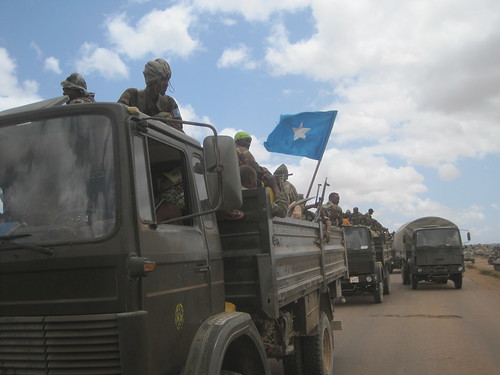
US-backed forces of the Somalia Transitional Federal Government and AMISOM enter the town of Wanlaweyn. The Horn of Africa nation is being occupied by imperialism utilizing proxy forces from the region., a photo by Pan-African News Wire File Photos on Flickr.
Don’t send more Amisom troops, build Somali Army
Updated Saturday, November 2nd 2013 at 23:15 GMT +3
By Billow Kerrow
The UN Security Council is set to approve an additional 4,000 troops for Amisom in Somalia to help the fledging government maintain security in that nation.
This follows the Africa Union request to send in more soldiers to fight Al Shabaab due to its threats to nations in the region. If this additional force is deployed, it will bring the total number of the Amisom troops from several African nations to 22,000.
Amisom controls Mogadishu, Kismayu and other major towns in the south of the country. According to the UN, Al Shabaab controls about a third of the territory. Recent UK media reports suggest that the organisation, which UN says has about 5,000 men, is regrouping, recruiting and training daily contrary to perceptions that they are finished.
The Guardian newspaper report quotes KDF sources saying that the group’s number could actually be three times more, and that in spite of being formally removed from Kismayu, Al Shabaab maintains a parallel underground administration that collects revenue from businesses.
The same report suggests that Amisom advances to other areas under the control of the group have lost momentum in recent months due to inadequate equipment.
My take is that both the AU and the UN are wrong in pursuing expansion of Amisom troops at the expense of building the capacity of Somalia’s defence forces. Its Army, estimated at just about 10,000 men converted from local militias, is so ill-equipped that it lacks the capacity to secure towns freed from Al Shabaab.
For a country as vast as Somalia, facing a major terrorist insurgency, its security forces do not have a single aircraft to help its forces mobilse when necessary. Its so-called Army, where the rank and file earn an inconsistent, paltry pay of $160 per month, suffers questions of trust and legitimacy because of their perceived affiliations to clans and regional powers.
It is illogical to invest so much resource in sending foreign armies to police the country, yet the national government urgently needs support to build its own security forces.
Amisom spends about US$500 million annually for deploying its 17,000 troops in Somalia. Regional countries spend similar amounts to support troops in that country.
Uganda’s budget for its forces in Amisom last year was about $100 million. Kenya probably spends even more. Yet, the impact of these foreign forces in Somalia is minimal in my view, relative to what a well trained and equipped Somali forces would have achieved.
First, the amounts spent on the proposed 22,000 Amisom forces annually is more than adequate to recruit 100,000 men into the Somali Army, complete with their artillery.
Secondly, there is little doubt that local Somalis understand the terrain and would, according to some UN reports, offer “better policing and better intelligence”.
It is also rational to suggest that properly equipped, trained and well remunerated Somali forces would easily overrun the insurgent groups, and be a more attractive alternative for the youth to join.
It makes pretty good sense to teach folks how to fish than to give them fish.
The Somalia Army even under the TFG regime suffered low morale and defection due to poor terms and the lack of adequate equipment to respond to threats.
Now that Somalia has a government that is recognised globally, it is time the international community invested in its people in order to help the nation build its capacity.
The Amisom forces can then be redeployed to its porous international borders to stop infiltration until security is restored in the country.
No comments:
Post a Comment